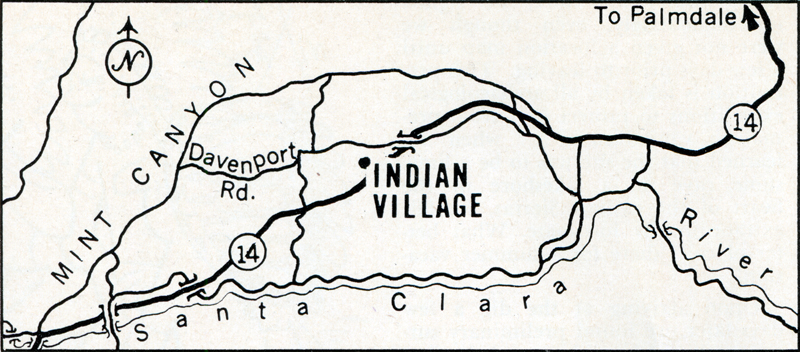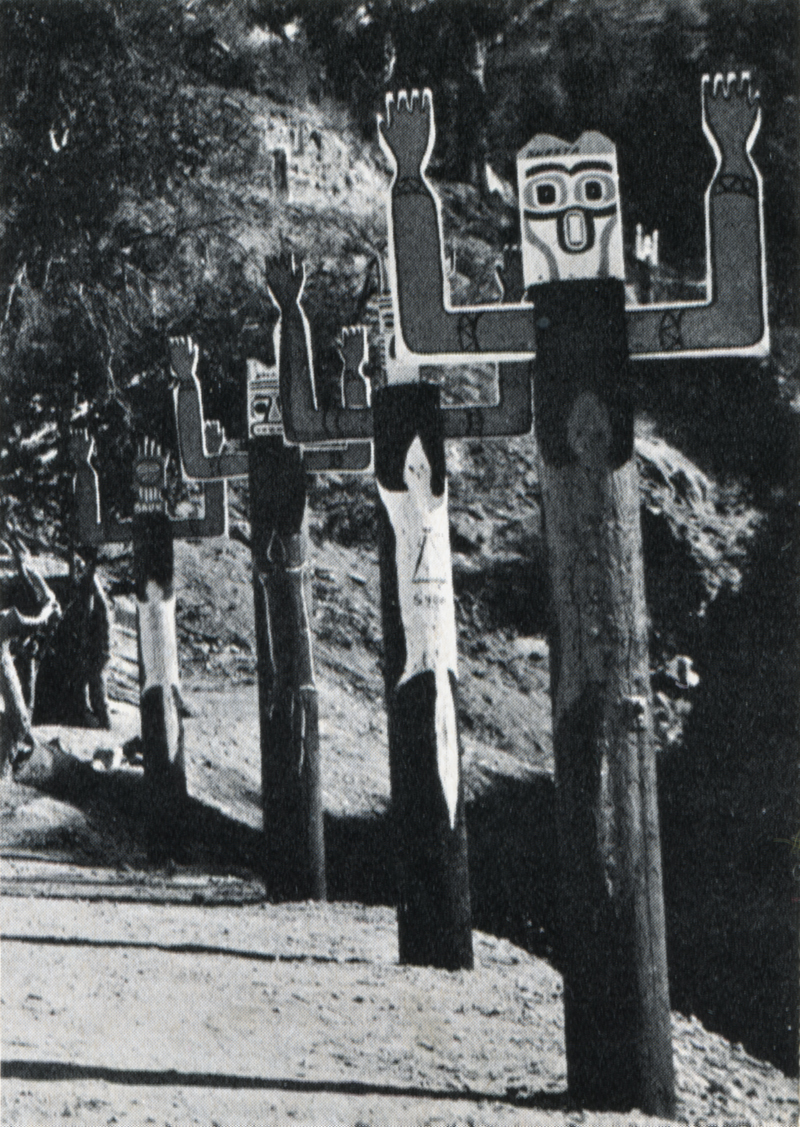|
|
New Indian-Frontier Village
By Margaret Romer
Desert Magazine | April 1965
|
Located in Mint Canyon, near Vasquez Rocks where the notorious bandit, Tiburcio Vasquez, harassed stagecoaches for 20 years (Desert Dec. '64), visitors can now rest securely in a verdant ravine where Vasquez watered and hid his horses. Another short walk leads to a spring that supplies an old green water tank built by the Indians and is still frequented by deer and bobcats that come down the mountain slope in the early morn. The Village doesn't stop with local history; it features that of our entire West. Near the creepy blackness of an abandoned gold mine, there's a replica of an old miner's hut, an early jail, and an outlaw's hideout. Then there's a white country church[1] such as dotted our country from Boston to Los Angeles a century ago. Inside is a conventional altar and genuine old pews cut down from ones that came around the Horn in a sailing vessel and were used in an early Los Angeles church. Not far from the church is a little red school house[2] with blackboard and scarred desks. The only things missing here are blonde pigtails to be dipped into inkwells by freckle-faced boys. Other reminders of the past include a "Chic' Sayles" outhouse, which makes you skeptical about how good were "the good old days" — especially in freezing winter weather! Scattered here and there everywhere are brightly colored totem poles. Mr. Callahan is 1/16 Mohawk Indian, which contributes to his intense interest in Indians and their tribal customs. He is also a descendant of John C. Calhoun, the renowned statesman and vice-president under Andrew Jackson. It must not be imagined that Mr. Callahan has been a dreamer all his life. Recently retired from the business world, he has been variously a run-away boy, a hobo, a dare-devil stunt man, an author, an actor, a business man and the producer of 52 documentary educational films on the life and customs of as many Indian tribes.
An outstanding exhibit is his Hopi kiva — one of the only two kivas in existence outside of Indian reservations. Both are here in the Village. Kivas are Indian Prayer Houses, but only men are permitted inside. There they go to hold religious ceremonies and commune with the Holy Spirit. There they pray for rain, or for the healing of a sick child, or for whatever is their immediate need. Ceremonies are said to be truly beautiful and deeply impressive. Here in the Village, women may enter the kiva as well as men. But all who enter remember it as a sacred place — the church of the Pueblo village. Other tribes are also represented. There's a Mohawk wigwam of 1670, a Sioux teepee of the turn of the century; a Seminole chichee of the same period; a Cherokee lodge; a Laguna pueblo; a Navajo hogan, and many others. Another unique exhibit is Good Luck Hall, decorated with over 10,000 horse shoes collected from Western ranches. Each shoe was actually worn by a faithful horse or mule that contributed his humble bit to the development of our great land. Here are 140 wagon and buggy wheels that actually rolled westward, each wheel bearing a descriptive tag. Visitors delight in finding ones from their own home states. Among them is one from the buggy which carried Helen Hunt Jackson across Southern California when she gathered material for her immortal novel Ramona. In the main building's museum hall if a wooden cradle that rocked Buffalo Bill (William Cody) when he was a babe; and another slept in by notorious Jesse James. And there stands the old pedal organ on which Carrie Jacobs Bond composed "I Love You Truly" and "The End of a Perfect Day." Mrs. Bond was a personal friend of Mr. Callahan. It has been necessary to charge a nominal admission fee to cover maintenance costs, but once inside you may stay as long as you like and wander at will. In sharing his knowledge and treasures with the public, Mr. Callahan has made a major contribution to American history and to the culture of Southern California. Everyone who leaves the Village does so with a deeper appreciation for modern advantages, comforts and conveniences, and a hearty respect for those who preceded us here. Webmaster's notes. 1. This is the Ramona Chapel, now at Heritage Junction Historic Park in Newhall. 2. Also at Heritage Junction. 3. Mission Village, a themed auto court at 5675 W. Washingon Blvd. in Culver City. Callahan opened it in 1926 and had to close it in 1962 because it stood in the way of the coming I-10 Santa Monica Freeway, which was completed in 1965.
Magazine page(s) purchased 2014 by Leon Worden; filed with photos. |
Pollack Story
Callahan & Carrie Jacobs Bond in Ramona Chapel 1927
Ramona Cottage ~1930s
~1940s
Callahan with Hopi Indians Employees
Good Luck Charm
'Hopi Snake Dance' Booklet
Description 1965
1967 Visit x3
Tom Shubert Story
Ray Saniger Performs 1967/70 (Mult.)
Summer of 1967
1972 Horror Film
Outlaw Saloon
Hopi Shrine
Red Schoolhouse
Ramona Chapel
Main Building
Good Luck Charm
Wrong Address
Good Luck Charm
Correct Address
$1,000 Las Vegas Loot
Schoolhouse Origin
The Callahan Collection: Donation Records
Schoolhouse Arrives 1987
Ramona Cradle x2
|
The site owner makes no assertions as to ownership of any original copyrights to digitized images. However, these images are intended for Personal or Research use only. Any other kind of use, including but not limited to commercial or scholarly publication in any medium or format, public exhibition, or use online or in a web site, may be subject to additional restrictions including but not limited to the copyrights held by parties other than the site owner. USERS ARE SOLELY RESPONSIBLE for determining the existence of such rights and for obtaining any permissions and/or paying associated fees necessary for the proposed use.

























